ISSN ONLINE(2319-8753)PRINT(2347-6710)
ISSN ONLINE(2319-8753)PRINT(2347-6710)
S.Senthil 1, C.Dinakaran 2
|
| Related article at Pubmed, Scholar Google |
Visit for more related articles at International Journal of Innovative Research in Science, Engineering and Technology
This paper mainly concentrates on smart grid technology using multilevel topologies. In this paper we have connected wind turbine, PV cell, Pico generator set so that the Electrical Energy is generated and it is connected to the Grid using multilevel Topologies. MULTILEVEL converters have been mainly used in medium or high power system applications, such as static reactive power compensation and adjustable-speed drives. In these applications, due to the limitations of the currently available power semiconductor technology, a multilevel concept is usually a unique alternative because it is based on low-frequency switching and provides voltage and/or current sharing between the power semiconductors. On the other hand, for low-power systems (< 10 kW), multilevel converters have been competing with high-frequency pulse width-modulation converters in applications where high efficiency is of major importance. Moreover, lower prices of power switches and new semiconductor technologies, as well as the current demand on high-performance inverters required by Renewable Energy Systems (RES), have extended the applications of multilevel converters. For the particular case of stand-alone RES, it is of common sense that it should be capable of supplying alternating current (ac) electricity, thus providing compatibility with standard appliances that are cheap and widely available. In addition, due the intermittent nature of almost all renewable energy (RE) sources, most single-consumer include an energy storage device that is usually implemented by lead-acid battery banks
Keywords |
| Renewable Energy Source, micro grid, smart grid, solar energy, wind farm. |
INTRODUCTION |
| According to these facts, it is evident that a device capable of converting a single dc voltage from a battery bank into an ac voltage is a key element of most stand-alone photovoltaic (PV) systems. These dc/ac converters, which are commonly referred to as inverters, have experienced great evolution in the last decade due to their wide use in uninterruptible power supplies and industrial applications. |
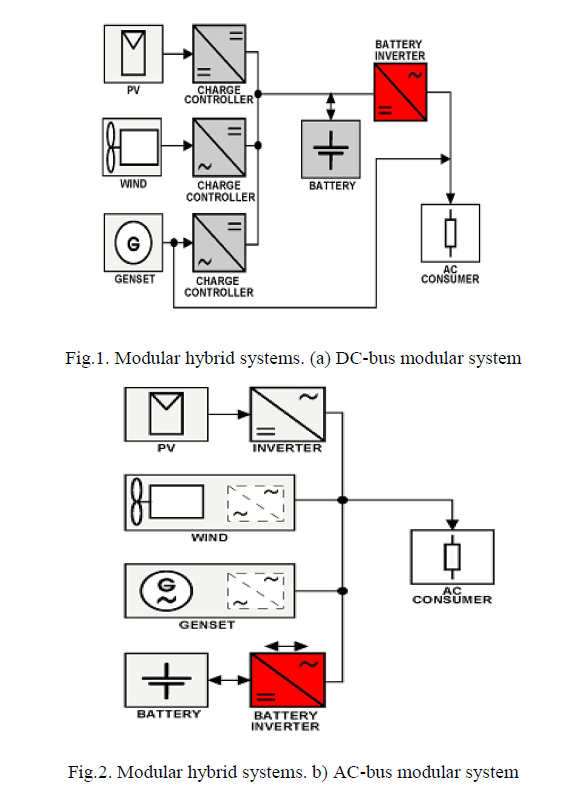 |
| According to these facts, it is evident that a device capable of converting a single dc voltage from a battery bank into an ac voltage is a key element of most stand-alone photovoltaic (PV) systems. These dc/ac converters, which are commonly referred to as inverters, have experienced great evolution in the last decade due to their wide use in uninterruptible power supplies and industrial applications. However, it is still a critical component to most SARES, and the development of high performance inverters is a challenge even today. Most of the small SARES for rural electrification present configurations that are variations of the complex hybrid systems that are presented in Fig. 1. In both dc- and ac-bus configurations, since the generator does not continuously operate and considering the intermittency of the RE sources, it is possible to conclude that the battery inverter should be designed to fully support the loads at some time periods. Therefore, independently of the system configuration, it is possible to identify that at least one “strong battery inverter” is required. Having in mind that SARES only make sense if they can be reliable and flexible, then all balance-of-system components must be accomplished with these characteristics. This way, to the best of the author’s knowledge, the most important characteristics of a RES battery inverter, concerning the order of importance, are as follows: 1) Reliability (most important); 2) surge power capacity; |
| 3) No-load consumption and efficiency. This paper investigates which multilevel topologies better meet the current demand on high-performance battery inverters for stand-alone PV system applications. |
II. BLOCK DIAGRAM |
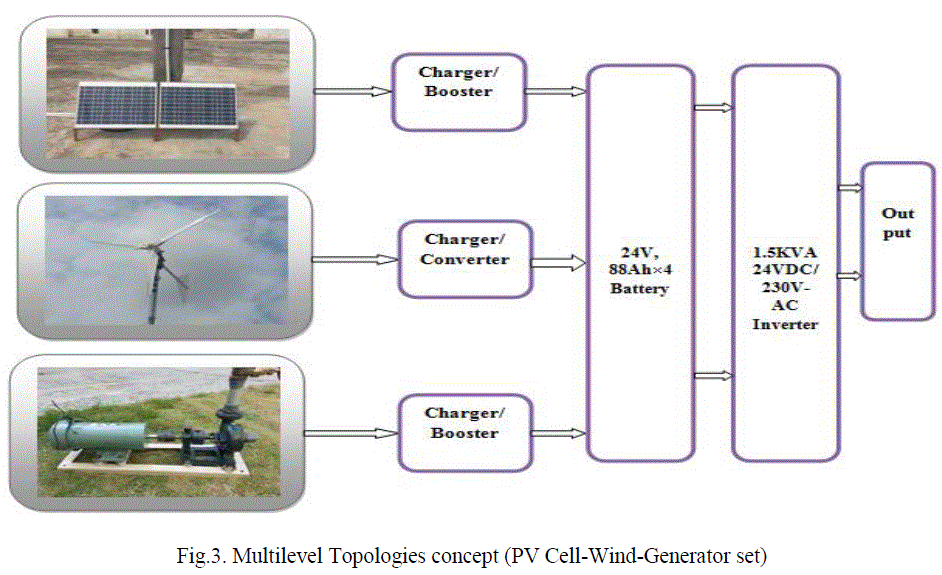 |
III. COMPILATION OF TOPOLOGIES |
| In this section, short reviews of the most common topologies are presented. Fig. below shows the topologies considered in this paper. |
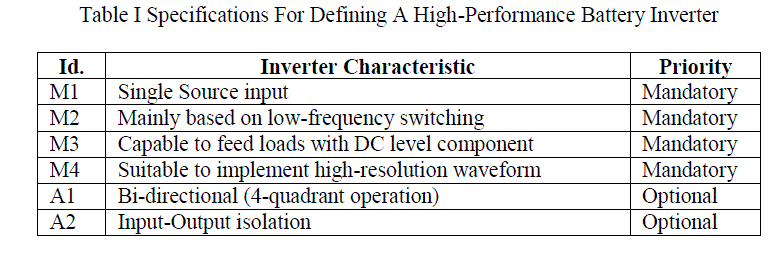 |
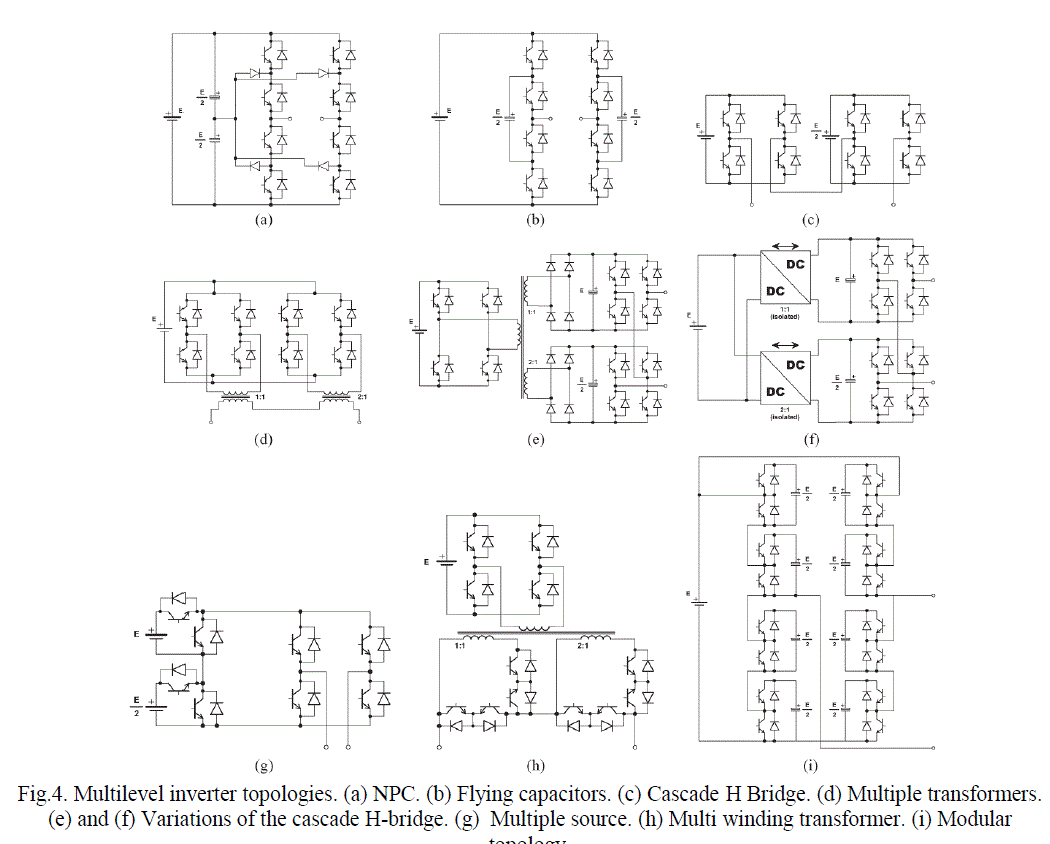 |
IV. TRIAL OF TOPOLOGIES |
| As discussed, most SARES require a single input battery inverter with improved characteristics of reliability, surge power capability, and efficiency. In addition, such kind of inverter must be capable of working with loads of diverse nature, such as house appliances, and, thus, must produce an output voltage with acceptable waveform quality. Taking into account these requirements, it is possible to define a list of characteristics required by a high-performance battery inverter, as presented in Table I. In accordance with Table I, the characteristics of all the topologies shown in Fig. 2 are summarized in Table II. As it can be seen in Table II, only three topologies meet all mandatory characteristics. While multiple-transformer and multi winding-transformer topologies meet all the characteristics, the H-bridge (multi winding transformer) does not support full four-quadrant operation. Finally, the presented analysis shows that the multiple transformer and multi winding-transformer topologies are the most suitable to implement high performance battery inverters. Table III shows the achieved design data and expected performance for these selected topologies. It is important to note that evaluation of the expected performance parameters took into account six factors. |
| Structures that can produce at least 12 steps per quarter cycle are assumed. This is a practical value that allows an output voltage regulation of approximately 40% (total harmonic distortion (THD) ≤ 5%) to be produced with a minimum number of switching transitions. Table II Summary Of The Characteristics Of The Most Common Multilevel Topologies |
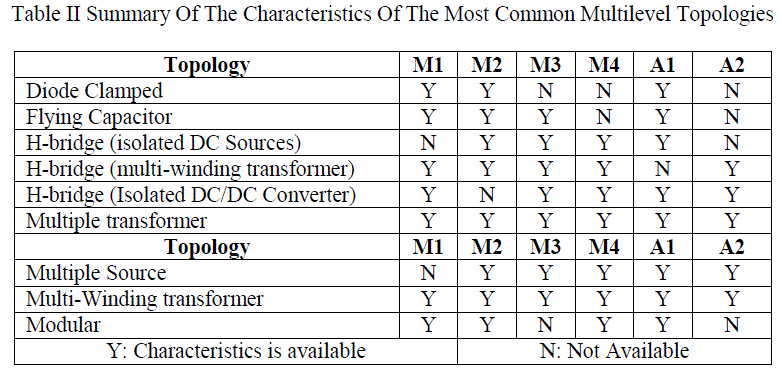 |
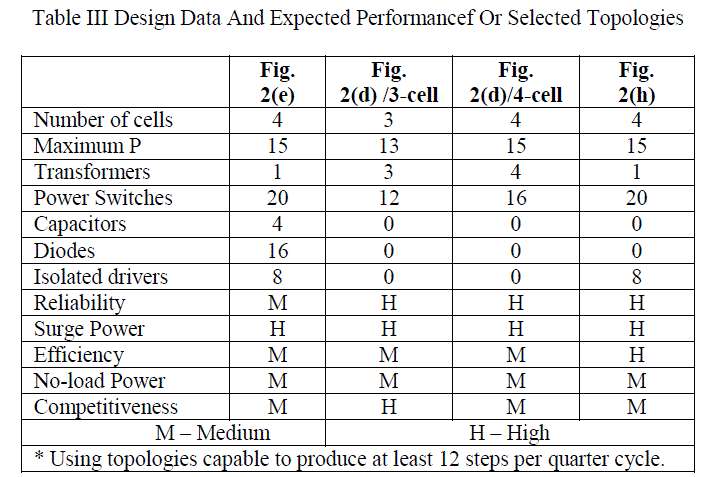 |
| ïÃâ÷ Reliability of the H-bridge inverter was lowered because of the presence of capacitors (usually electrolytic). ïÃâ÷ Efficiency of the H-bridge inverter is limited by the rectifier diodes. ïÃâ÷ Efficiency of both multiple-transformer/three-cell and four-cell inverters is limited by the possible reverse power flow, which is a situation that occurs when additional levels are produced by reverting the polarity of one or more cells in respect to the output voltage polarity (subtraction of levels). In addition, several individual transformers are employed, and each one always carries the total current at any instant. ïÃâ÷ Conversion efficiency of the multi winding-transformer inverter is considered high because it uses only one transformer and the load current is shared between transformer output coils and switches. ïÃâ÷ Market competitiveness of the multiple-transformer three-cell inverter is considered high because the additional cost of the three transformers is compensated by the reduced number of power devices and drivers. The presented analysis shows that the multiple-transformer and multi winding-transformer topologies are the most suitable to implement high-performance battery inverters. It is also expected that the multi winding transformer topology can achieve better efficiency than the multiple-transformer one if same rules and similar components are used in their design. |
V. SIMULATION OUTPUTS |
| The graph shows that the output waveform is in a multilevel Inverter the modulator circuit generates the control signals for all the power components in the power stage. Generally, it is important that the harmonic components of output voltage produced by inverter itself should be reduced to alleviate the output current ripple and the core loss of inductor. The developed inverter is simulated and the output voltages waveforms are represented. The figure represents the simulated results of output voltage and current. |
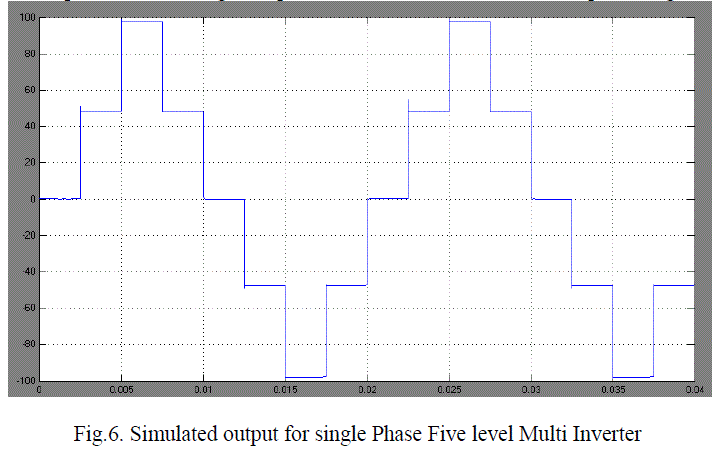 |
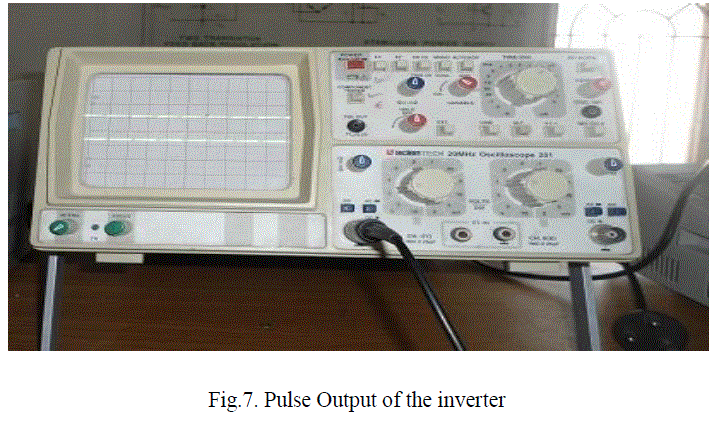 |
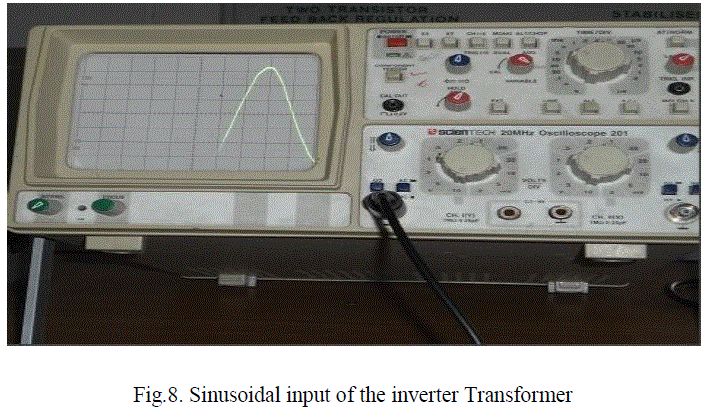 |
| Generally, it is important that the harmonic components of output voltage produced by inverter itself should be reduced to alleviate the output current ripple and the core loss of inductor by the sinusoidal PWM techniques. The developed inverter is simulated and the output voltages waveforms are represented. The CRO waveforms showed the hardware pulse output, sinusoidal input and sinusoidal output voltage and current. The 5V PWM is triggered the MOSFET and 24V DC is also connected to the MOSFET. Therefore the 48V is obtained from the inverter circuit .The 48V sinusoidal input is given to inverter transformer and 230V, 15A output directed to utility feeder. |
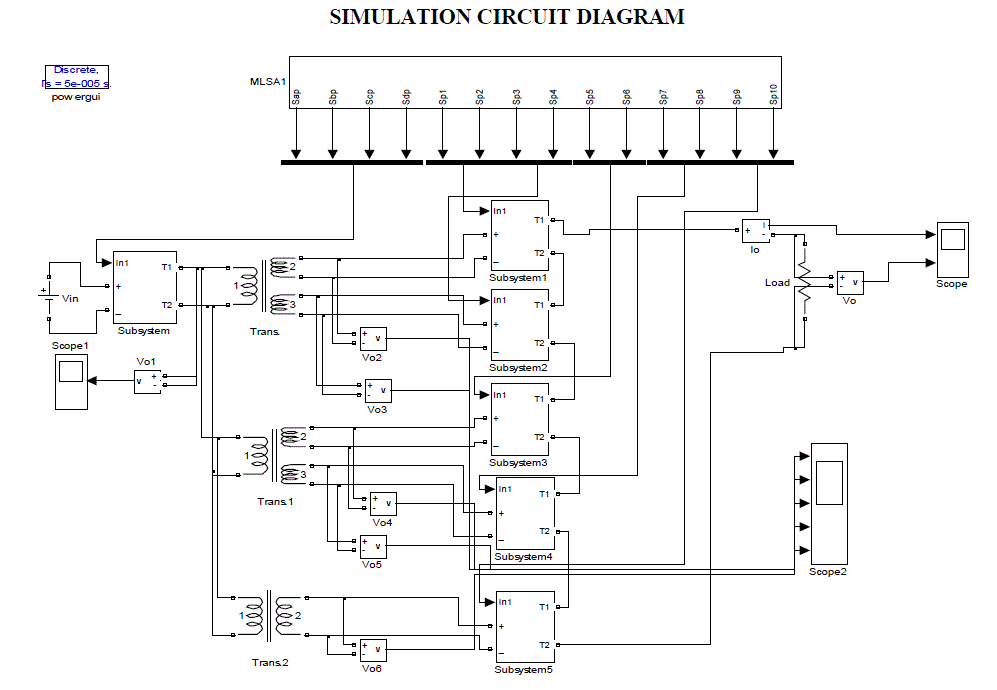 |
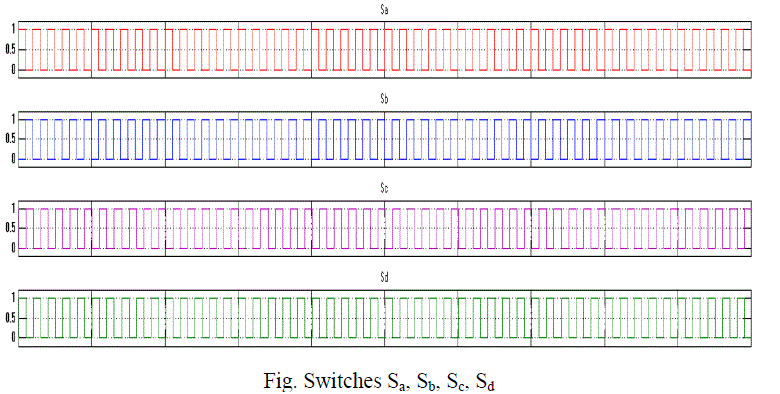 |
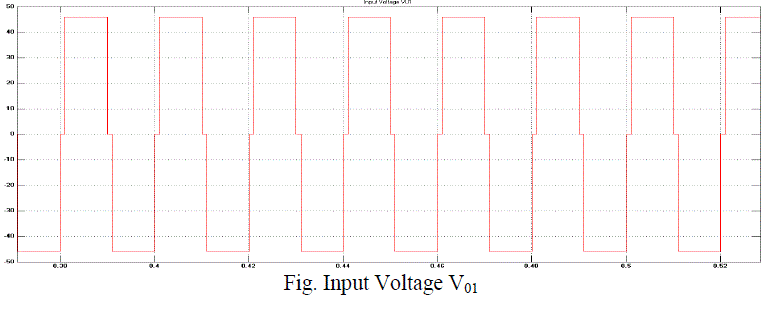 |
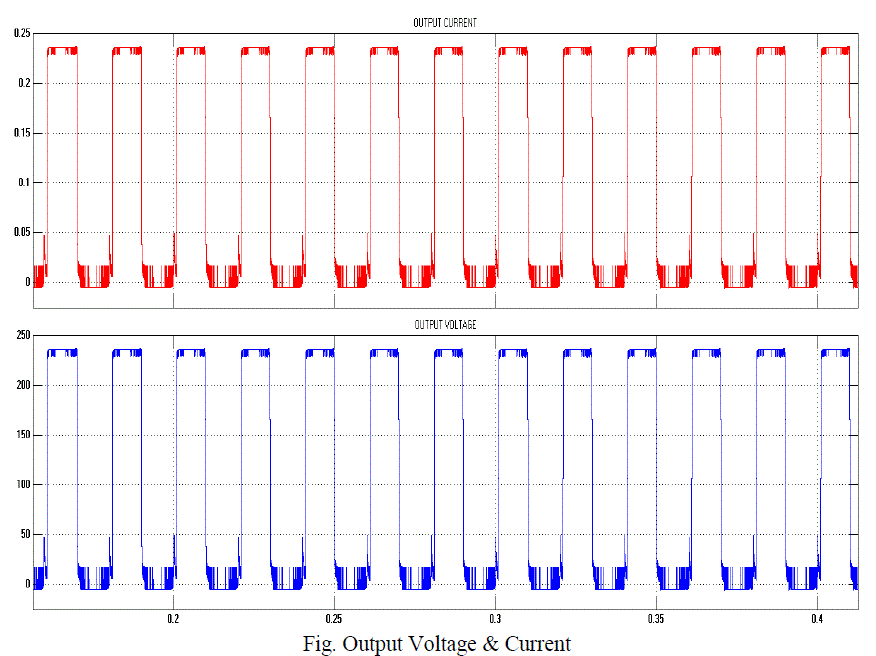 |
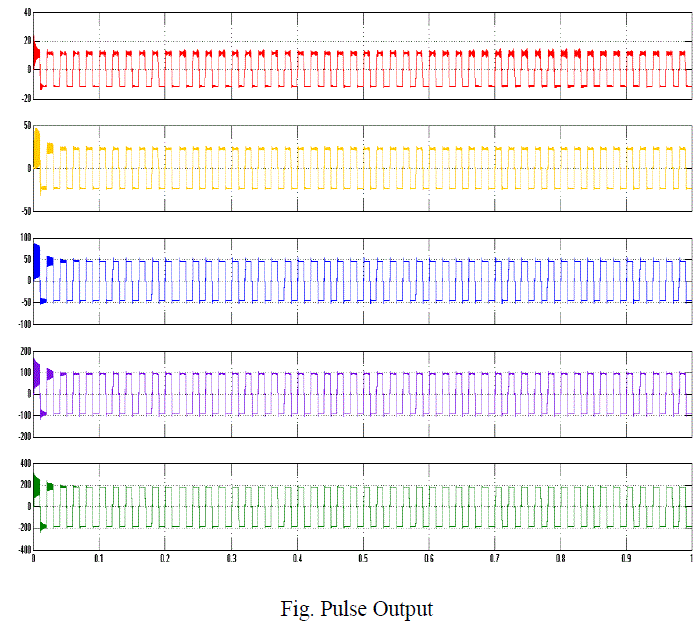 |
VI. CONCLUSION |
| It is concluded that the smart grid technology is adopted using the resources available like Solar, Wind and Pico Hydel the Electrical Energy is generated and it is converted into required supply. By using Booster converter the constant output voltage is maintained for the battery charging system. Even more, it was concluded that either dc or ac busbased systems demand on at least one reliable or robust battery inverter, which should be capable of directly attending all consumer ac loads. It is proposed that this current demand on high-performance battery inverters can be reached by using multilevel topologies, and it is shown that the most suitable topologies are the multiple transformer and the multi winding transformer. The implemented prototype was based on the multi winding-transformer topology, and it has proved itself to be robust, presenting peak efficiency of 96.0%. The proposed inverter can be considered a top-efficiency inverter for the power range of about 1.5 kVA. |
References |
|